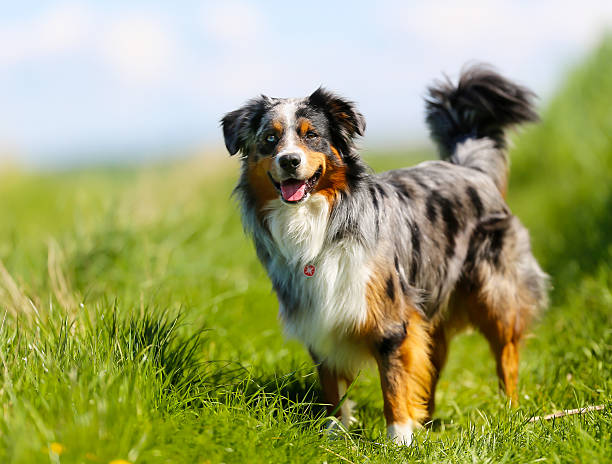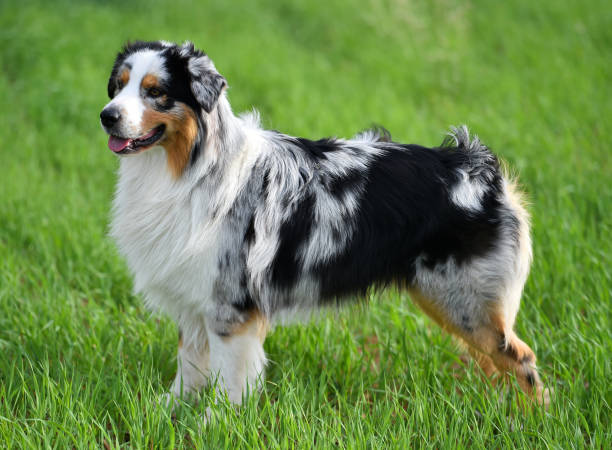The Australian Shepherd Dog: History, Appearance, Temperament, Health, Grooming, Training and Care
The Australian Shepherd, often affectionately called the “Aussie,” is a medium-sized herding dog breed that has captured the hearts of dog lovers around the world with its intelligence, energy, and versatility. Despite its name, the breed’s origins are firmly rooted in the United States rather than Australia, where it earned its nickname. Renowned for its striking appearance, boundless enthusiasm, and loyal temperament, the Australian Shepherd is a beloved companion for working ranchers, competitive dog sport enthusiasts, and families alike.

Historical Origins and Development
The history of the Australian Shepherd is a fascinating blend of migration, ranching culture, and canine breeding aimed at producing an exceptional herding dog. Contrary to popular belief, the Australian Shepherd did not originate in Australia. The breed’s name traces back to the late 19th and early 20th centuries, when Basque shepherds migrated from Australia to the western United States, bringing with them their herding dogs. These dogs were then bred with various herding dogs already present in the U.S., including Collies and other working breeds.
The result was a highly adaptable and intelligent dog capable of managing livestock across vast ranches and tough terrains. Ranchers in states such as California, Colorado, and Montana favored these dogs for their agility, endurance, and keen herding instincts. Through decades of selective breeding focusing on functionality, temperament, and health, the Australian Shepherd emerged as a distinct breed by the mid-20th century. The American Kennel Club (AKC) officially recognized the Australian Shepherd in 1991, cementing its status as a beloved working and companion dog.
Physical Appearance and Breed Standards
The Australian Shepherd is a well-proportioned, athletic dog with a strong build that reflects its herding origins. Generally medium in size, males typically stand between 20 to 23 inches tall at the shoulder, while females are slightly smaller, ranging from 18 to 21 inches. Weight varies between 40 and 65 pounds, with males usually larger than females.
One of the most striking features of the Aussie is its expressive, almond-shaped eyes, which can be brown, blue, amber, or even heterochromatic (each eye a different color). This trait adds to the breed’s captivating and intelligent expression.
The Australian Shepherd’s coat is of moderate length, dense, and weather-resistant, featuring a straight to slightly wavy texture. The breed standard allows for a variety of colors and markings, including:
-
Blue Merle: A marbled coat of black and gray with black patches.
-
Red Merle: A mottled combination of reddish-brown and lighter patches.
-
Black: Solid black or black with white and/or tan markings.
-
Red (Liver): A rich reddish-brown with possible white and/or tan markings.
White markings commonly appear on the chest, legs, face, and collar. Tan points are typical on red and black dogs, often found above the eyes, on the cheeks, and legs. The breed’s coat is not only aesthetically pleasing but also practical, providing insulation in various climates.
The Australian Shepherd typically sports a bobbed tail or a naturally short tail, which was historically preferred to avoid injury while working with livestock.

Temperament and Personality
Known for their remarkable intelligence and intense work ethic, Australian Shepherds possess a temperament that combines alertness, friendliness, and loyalty. They are highly energetic and require mental and physical stimulation to thrive, making them ideal for active families and individuals who enjoy outdoor activities.
Aussies are deeply attached to their owners and often form strong bonds with family members, including children and other pets when properly socialized. They tend to be protective without being aggressive, alerting their owners to strangers or unusual activities while remaining friendly and approachable once trust is established.
Their intelligence makes them highly trainable, and they excel in obedience, agility, herding trials, search and rescue, and various dog sports. However, their keen intelligence can also lead to mischievous behavior if left bored or under-stimulated, which underscores the importance of providing consistent training and engagement.
Socialization from an early age is critical for Australian Shepherds to develop well-rounded behaviors, helping to moderate their natural herding instincts, which might include nipping at heels or chasing moving objects. When properly channeled, these traits can be wonderful assets in many canine activities.
Health and Lifespan
Australian Shepherds are generally healthy dogs with a lifespan ranging from 12 to 15 years. Nonetheless, like all breeds, they are prone to certain genetic and health conditions that prospective owners should be aware of.
Some of the most common health issues in Australian Shepherds include:
-
Hip Dysplasia: A genetic malformation of the hip joint that can lead to arthritis and mobility problems. Responsible breeding and screening programs have reduced the incidence.
-
Elbow Dysplasia: Similar to hip dysplasia but affecting the elbow joint.
-
Progressive Retinal Atrophy (PRA): An inherited eye disorder causing gradual vision loss and eventual blindness.
-
Cataracts: Clouding of the eye lens that can impair vision.
-
Collie Eye Anomaly (CEA): A congenital condition affecting the retina and other eye structures.
-
Epilepsy: A neurological disorder causing seizures.
-
Multidrug Resistance Mutation (MDR1): A genetic mutation found in many herding breeds, including Aussies, that causes sensitivity to certain drugs.
-
Autoimmune Disorders: Such as autoimmune thyroiditis or allergies.
Reputable breeders perform health screenings for these conditions to minimize risks, and responsible owners ensure regular veterinary check-ups and preventive care.
Grooming and Care
Australian Shepherds have a double coat consisting of a dense undercoat and a longer, protective outer coat. Grooming is essential to maintain the health and appearance of their coat and to prevent matting or skin issues.
Brushing two to three times a week is generally sufficient to remove loose hair and distribute natural oils. During seasonal shedding periods, more frequent brushing may be required. Aussies are moderate shedders, with more shedding typically in spring and fall.
Bathing should be done as needed, typically every few months, unless the dog becomes particularly dirty. Over-bathing can strip the coat of essential oils, so balance is important.
In addition to coat care, regular maintenance includes:
-
Nail trimming: To prevent overgrowth and discomfort.
-
Ear cleaning: To prevent infections, especially since Aussies have moderately sized, floppy ears.
-
Dental hygiene: Regular teeth brushing and dental checkups help prevent periodontal disease.
-
Eye care: Monitoring for any signs of irritation or abnormalities.
Training and Exercise Needs
Given their herding background and high intelligence, Australian Shepherds require plenty of physical activity and mental challenges to remain healthy and happy. Without adequate exercise, they may develop behavioral problems such as excessive barking, chewing, or digging.
Daily exercise should include at least one to two hours of vigorous activity, which can include walks, runs, playtime, agility training, or herding exercises. Many Aussies thrive in dog sports like agility, flyball, obedience competitions, and herding trials, which not only challenge their bodies but also stimulate their minds.
Training an Australian Shepherd is usually rewarding because of their eagerness to please and learn. They respond well to positive reinforcement techniques such as treats, praise, and play. Early socialization and obedience training are essential to ensure they grow into well-behaved, balanced adults.
Australian Shepherd as a Working Dog
Beyond companionship, the Australian Shepherd remains a highly valued working dog on ranches and farms around the world. Their herding instincts are still strong, and they are adept at managing livestock such as sheep, cattle, and goats.
Their agility, stamina, and intelligence make them excellent at guiding, gathering, and controlling animals in diverse and challenging environments. Ranchers rely on the Aussie for its ability to work independently and follow complex commands, often without needing a leash.
The breed’s versatility extends beyond herding into roles such as search and rescue, therapy dog work, and even assistance dog roles, demonstrating its adaptability and desire to work.
Australian Shepherds in Popular Culture
The breed’s striking looks and remarkable talents have made it a popular choice in media and pop culture. Australian Shepherds have appeared in movies, television shows, and commercials, often depicted as smart, loyal, and energetic companions.
Their strong work ethic and trainability have also made them favorites among celebrities and dog sport enthusiasts. The Aussie’s reputation as a highly skilled herder and a family-friendly pet continues to grow, cementing its place as one of the most beloved breeds in the United States and beyond.
Considerations Before Getting an Australian Shepherd
While Australian Shepherds are wonderful dogs, potential owners should consider their specific needs and lifestyle requirements before bringing one home. Aussies thrive in active households with plenty of outdoor space and opportunities for exercise and engagement.
They do not adapt well to sedentary lifestyles or long periods of isolation. Without proper stimulation, they may develop destructive behaviors or become anxious. Their high energy level and strong herding instincts may also require supervision around small children or other pets, especially if not socialized early.
Prospective owners should be prepared to invest time in training, exercise, grooming, and mental enrichment. This breed is best suited for people or families who can commit to meeting these needs, such as ranchers, outdoor enthusiasts, agility competitors, or active families.
Final Thoughts
The Australian Shepherd is a remarkable breed that combines beauty, brains, and boundless energy in a medium-sized, athletic package. Its origins as a working herding dog, combined with its loyal and loving nature, make it a versatile companion for those who appreciate its unique qualities.
Whether you are drawn by their striking merle coats, their sparkling eyes, or their incredible intelligence and trainability, Aussies offer an unparalleled bond and a lifetime of companionship—provided their needs for activity, training, and care are met.
For those willing to invest in understanding and nurturing the Australian Shepherd’s physical and emotional needs, this breed promises a rewarding partnership filled with adventure, affection, and endless enthusiasm.
Photo from: iStock
0 Comment to "The Australian Shepherd Dog: History, Appearance, Temperament, Training, Health, Grooming, Care, Family and Lifestyle"
Post a Comment